Mastering AWS Infrastructure Testing with LocalStack Cloud Pods - on localhost, CI and Testcontainers
Discover how LocalStack Cloud Pods enable efficient testing of your applications by providing snapshots of AWS infrastructure for local development, continuous integration, and Testcontainers integration.
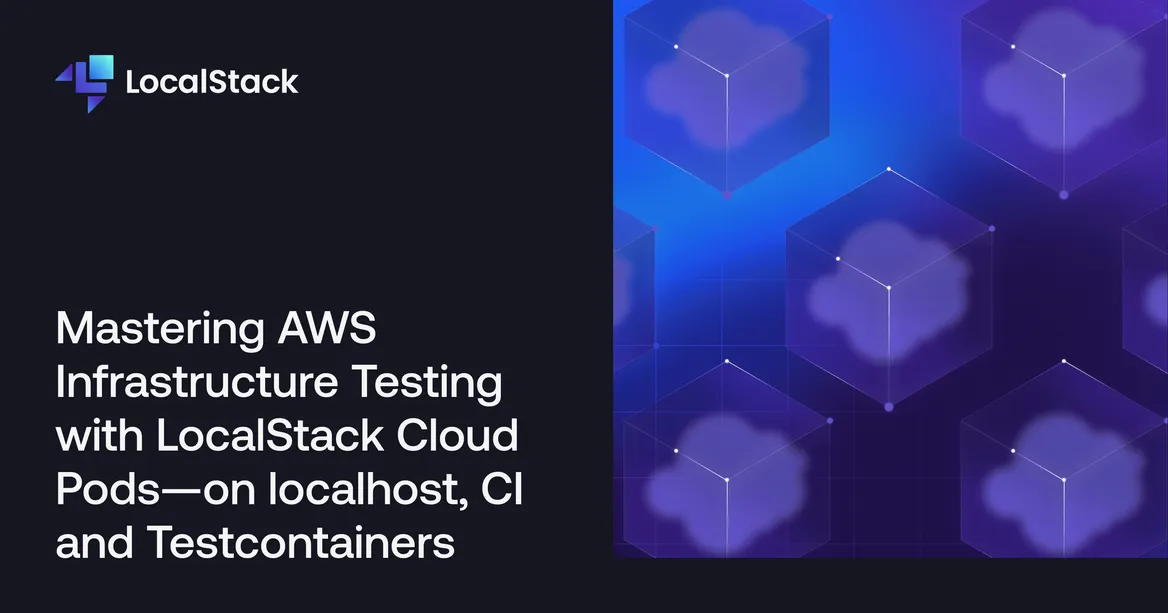
Cloud Pods, State & Persistence in the LocalStack ecosystem
In a few words, LocalStack is a cloud service emulator that allows you to develop and test your cloud and serverless applications locally by replicating AWS environments on any machine without the need to deploy them to the actual AWS cloud. This tool provides an easy and cost-effective way to test cloud applications by locally providing all the necessary dependencies.
LocalStack ships as a Docker container, making its state ephemeral by default. Once the container shuts down, all the services and data are gone. So, in an attempt to solve this issue, the LocalStack engineers came up with some solutions that could be applied on a case-by-case basis. These are Persistence, State, and Cloud Pods. To better understand the differences between these approaches, we can simplify them in a diagram:
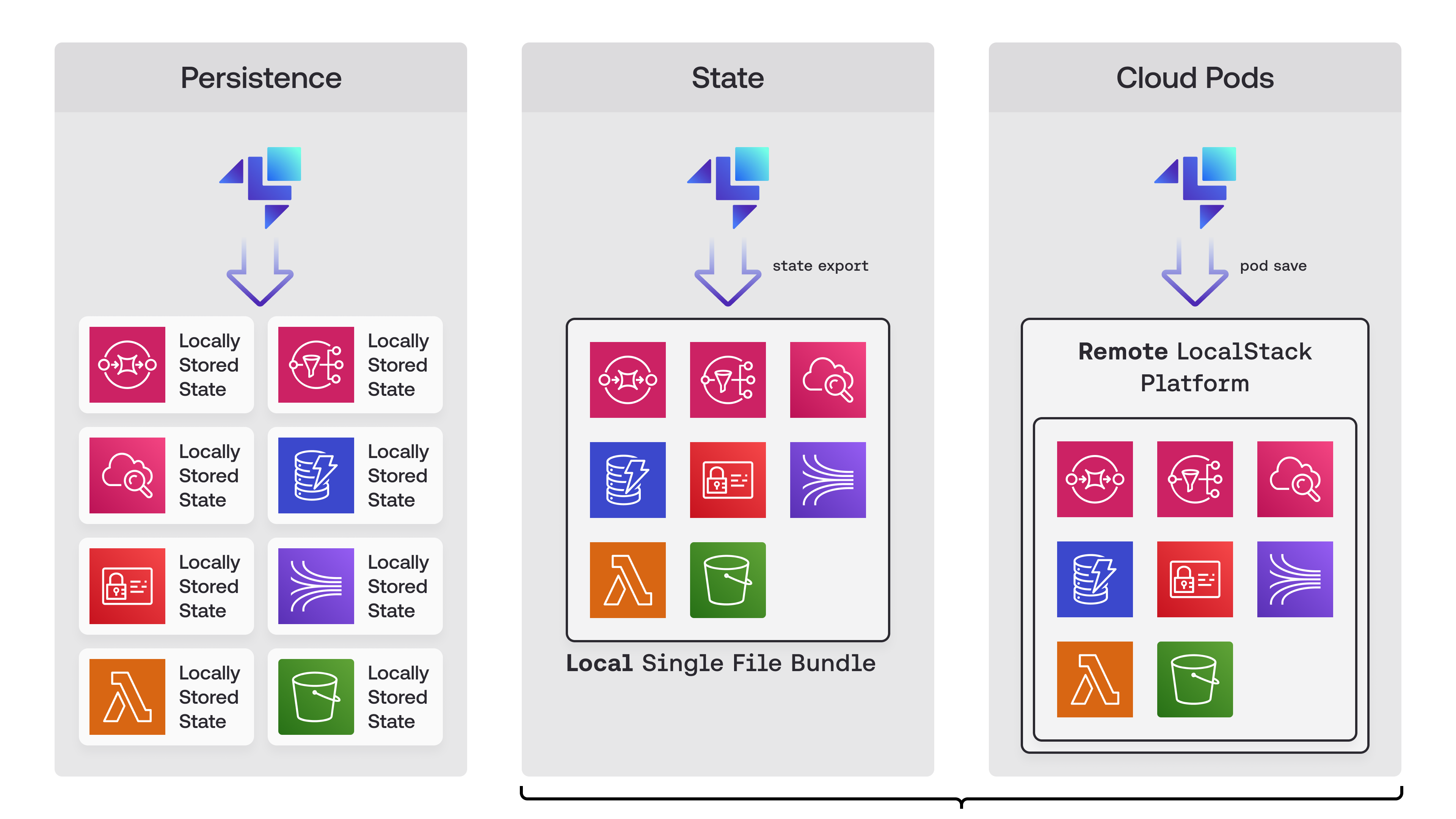
Anything that is inside a LocalStack container constitutes the “state.” The “state” can either be persisted on your local
machine and be loaded at startup, exported anytime as a single local file (state export), or stored on the LocalStack platform (cloud pods).
The underlying mechanisms of all three solutions are similar, but the layout obviously differs. We can observe how using state
locally and Cloud Pods are very similar, one might even consider them local and remote Pods. That being said, in this
article, we will focus on Cloud Pods and what problems they solve while glancing at the local state from time to time.
Simply put, a Cloud Pod is a persistent state snapshot of your LocalStack instance. Think of it as a snapshot of a database from which you can restore the tables and all associated data.
Cloud Pods are not very rigid, though. They also enable users to selectively capture the configuration and data of only specific services, making them highly adaptable and tailored to diverse development and testing needs.
Cloud Pods: How do they work?
There are several reasons why the concept of Cloud Pods plays a crucial role in the LocalStack ecosystem.
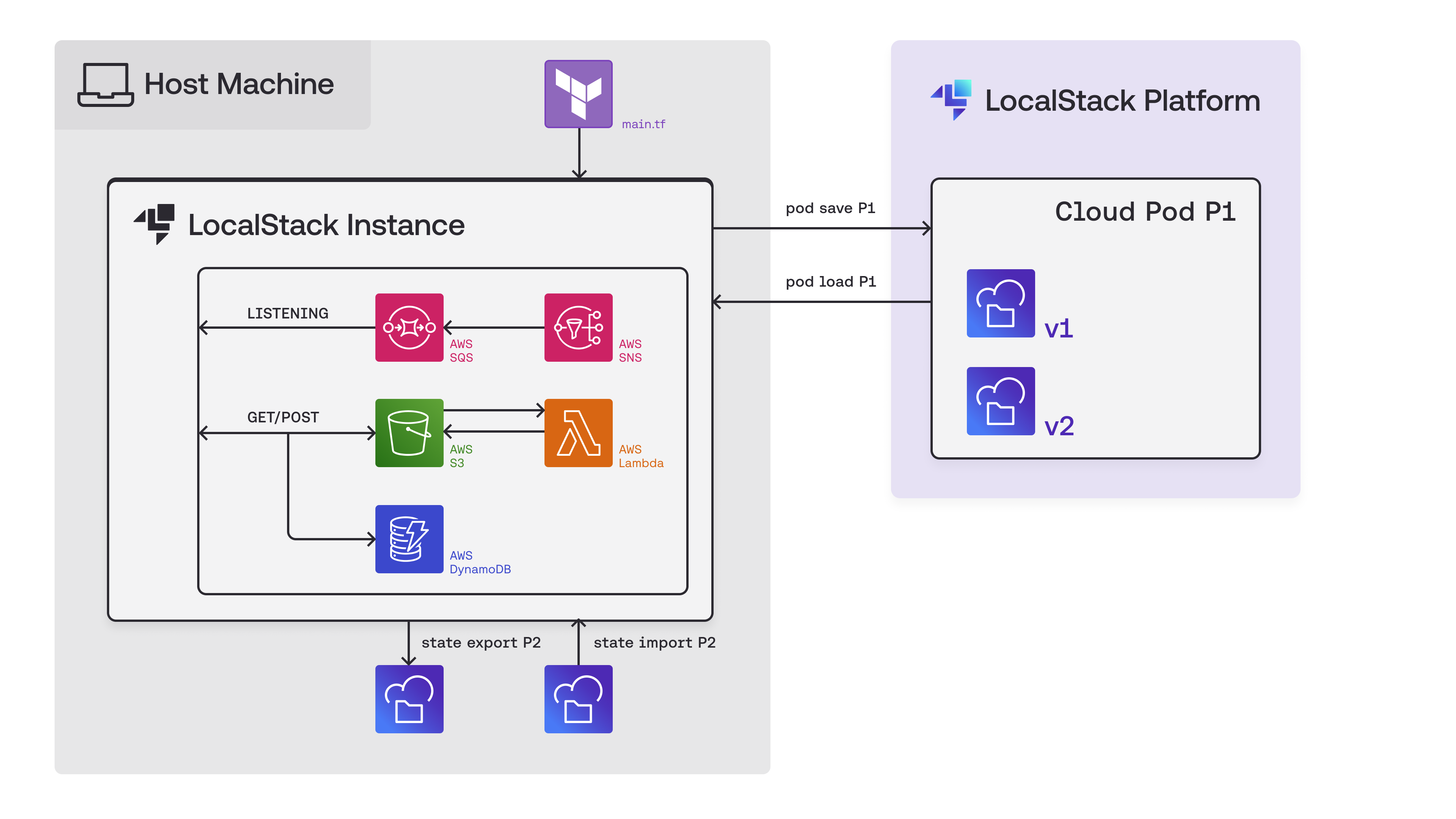
Focusing solely on Cloud Pods and state, this diagram illustrates the relationship and workflows between the LocalStack instance, local state, Cloud Pods, and the LocalStack Platform:
- The LocalStack Instance runs on a host machine, and the required infrastructure is created via a Terraform configuration file. The AWS resources interact with each other, meaning that more complex cloud scenarios can be tested.
The LocalStack Instance can locally export its state by using the state export command, and at the same time, it can
inject a state using state import.
- The LocalStack Platform (on the right) stores Cloud Pod artifacts by default when using the
pod savecommand. When pushing an already existing pod, a new version is created and subsequently uploaded to the platform. Complementary, thepod loadcommand is used to inject a Cloud Pod.
The user can emulate AWS cloud services on their local machine with LocalStack, save the configurations into versioned Cloud Pods, and additionally share or store these configurations on the LocalStack Platform. It’s a way to manage development and testing environments with reproducibility and version control. The state management section of the documentation offers a comprehensive explanation of all the CLI commands.
Why use Cloud Pods
Sharing and Collaboration
LocalStack’s snapshot feature significantly enhances team collaboration on cloud applications by enabling the capture and sharing of AWS services’ precise configurations and data. This ensures consistent development environments across teams, resolves discrepancies, and facilitates efficient onboarding and troubleshooting. By simplifying the synchronization of workspaces through LocalStack’s remote platform, Cloud Pods accelerates development cycles and ensures faster and more dependable tests.
Modularity and Flexibility
LocalStack’s Cloud Pods offer enhanced modularity and flexibility, enabling teams to configure distinct, purpose-specific testing environments. For instance, one Cloud Pod can replicate a production database for final-stage testing, while another can host a database filled with edge cases for validation testing. This nuanced approach not only allows targeted testing of application components under changing conditions but also strengthens test integrity by preventing data overlap and ensuring isolation.
Another practical application is providing layering of different datasets on the same infrastructure, which is crucial for machine learning applications to create reproducible samples. This method ensures that training datasets and the corresponding code logic for ML models are packaged together, enhancing reproducibility and streamlining development workflows in an engineering-focused environment.
Efficiency and Speed
Cloud Pods boost efficiency in cloud application development by cutting down environment setup times. Compared to traditional infrastructure provisioning, like a full Terraform stack setup, LocalStack’s injection of pre-configured Cloud Pods reduces setup time from minutes to mere seconds. This rapid deployment not only accelerates the development cycle but also allows developers to focus more on actual work and less on waiting, aligning perfectly with the demands of agile methodologies and fast-paced project timelines.
”Talk is cheap. Show me the code.”
We’ve mentioned some of the strong points of Cloud Pods. Let’s now see them deliver on those promises. You can follow along with all the examples by cloning the demo repository.
Accelerating development and testing
The following recording shows the comparison in time spent waiting for the same infrastructure to be set up, first using Terraform and then via Cloud Pods:
The results speak for themselves: 1 minute 32 seconds vs 15 seconds. If your stack is generally stable and is not actively
being built, you can easily focus on your application logic and use Cloud Pods rather than provision your infrastructure
using IaC tools every time. Alternatively, you can also export the state of your LocalStack instance or create a Cloud Pod
using only the desired services with the --services flag.
Now, we can kick it up a notch and introduce the same speed in CI. This example follows three workflows described in the same repository. All the runs are doing the same thing: setting up the environment, starting LocalStack, spinning up the desired resources, and, as a final check, verifying if the buckets with the correct name exist.
We can see that both workflows using Pods have a shorter running time, whether they’re using local files or remotely stored ones. This is also because you can skip some more steps in the workflows, such as installing Java and Maven and building the Lambda jars. For a one-time run, the differences are 1 minute and 42 seconds and 1 minute 40 seconds, but let’s remember that this stack is only using a few services: IAM, STS, SQS, SNS, DynamoDB, S3, Lambda, KMS, Kinesis, and CloudWatch. All these minutes add up with every workflow you run, and in this scenario, the run time went down by 42,8% and 42%, respectively. Meanwhile, the developer running this on their machine has reduced the waiting time by 84%.

Optimizing collaboration and enhancing teamwork
In this instance, we’ll see how Cloud Pods improve team collaboration by optimizing AWS infrastructure updates. From a bird’s eye view, the process looks like this:
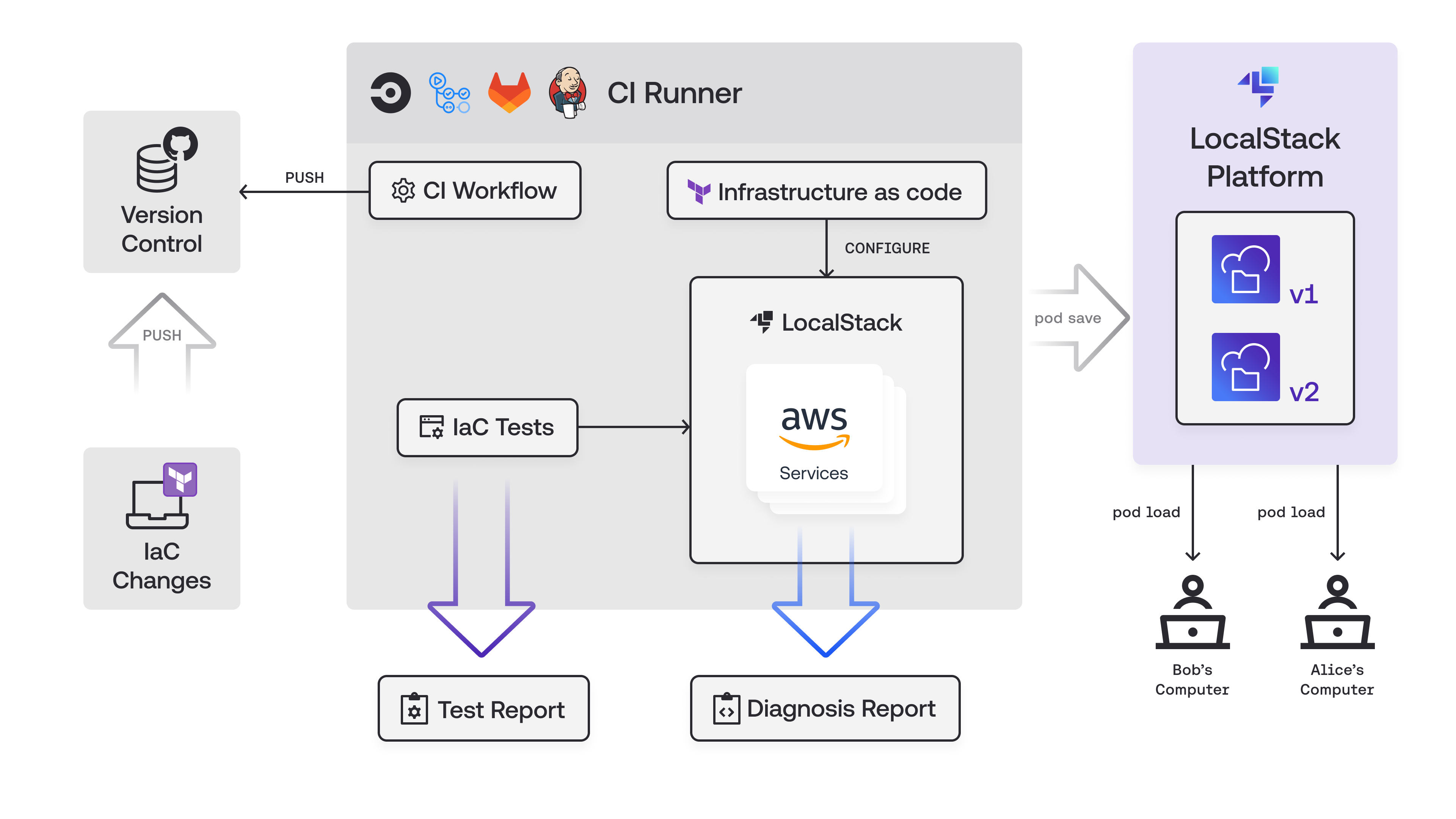
We utilize a GitHub Action to trigger a workflow whenever the IaC configuration files are
modified (.github/workflows/create-cloud-pod-on-infra-change.yml). This action creates a new Cloud Pod and uploads it to
the LocalStack Platform, providing a centralized access point for the team. Consequently, our application’s build and test
workflows can incorporate the newest Pod (terraform-shipment-pod), ensuring that everyone consistently works with the latest
infrastructure changes. This method ensures that each team member is aligned with the most recent developments, promoting
efficiency and coherence in engineering processes.
After each run, the updated Cloud Pod version is visible in the web application dashboard.
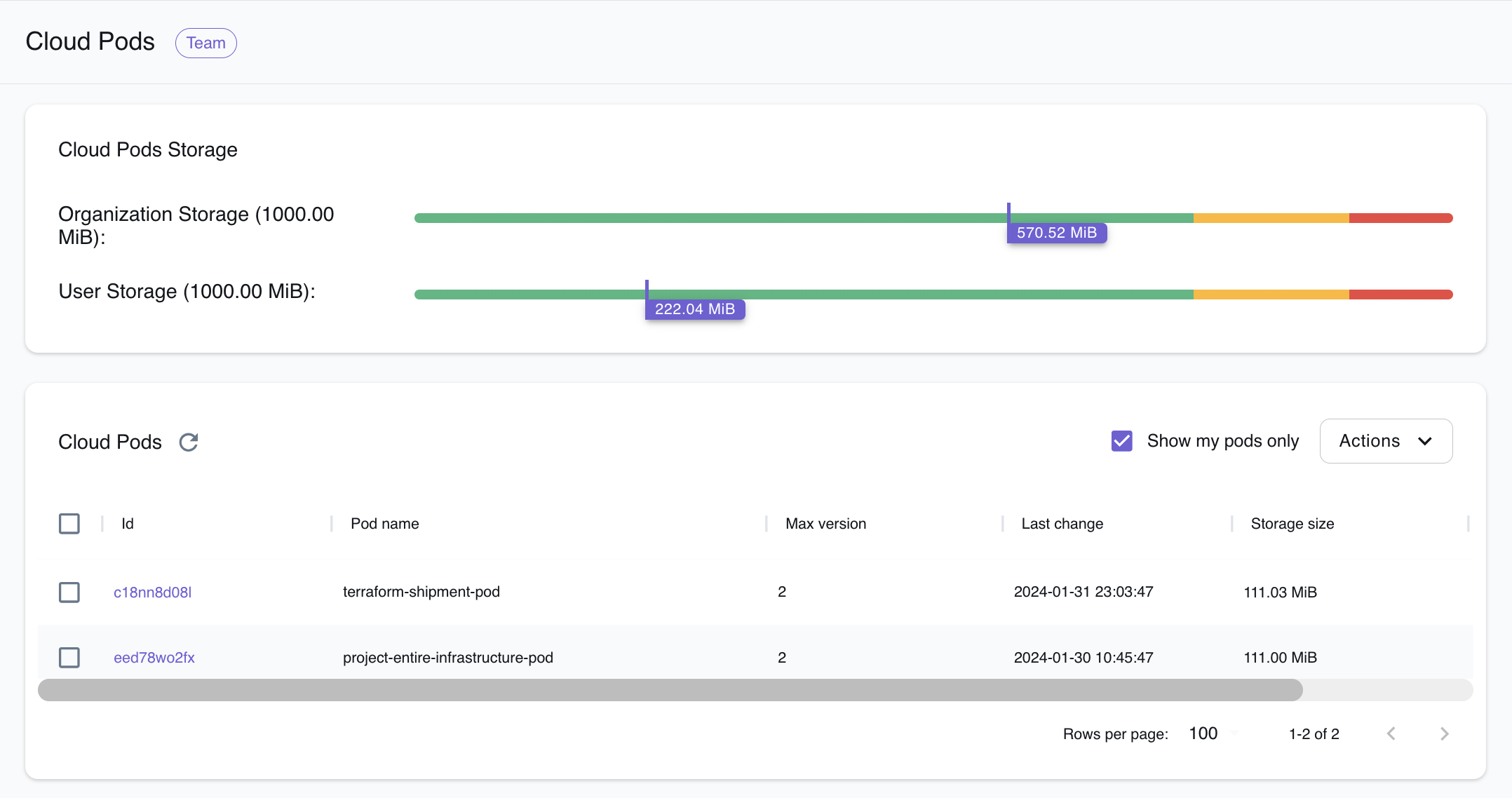
Upon closer inspection, the user can discover more information about each version of the Cloud Pod and, if needed, can choose from any older rendition to recover the LocalStack state. Be careful though, there is an auto-cleanup setting that will make sure old versions of Cloud Pods are cleaned up automatically. All versions of a Cloud Pod that exceed a threshold set by the users will be deleted. This can be 5, or it can be 20, depending on your needs.
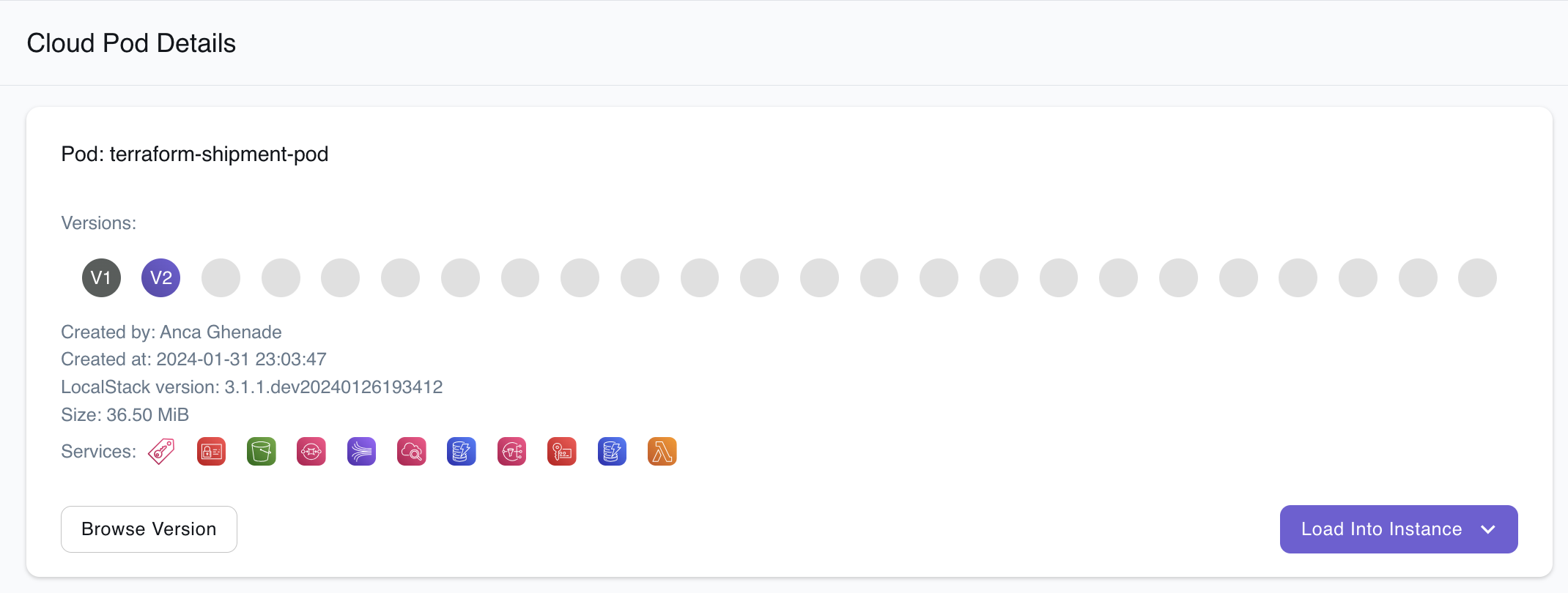
The integration of Cloud Pods into your CI pipelines significantly streamlines the process. Once new code is pushed and the workflow starts, LocalStack retrieves a Cloud Pod and pre-seeds its state in a matter of seconds, enabling integration tests to start as fast as possible. This swift setup significantly accelerates CI runs, ensuring rapid feedback and a more efficient development cycle while also enhancing the overall robustness and reliability of the development pipeline.
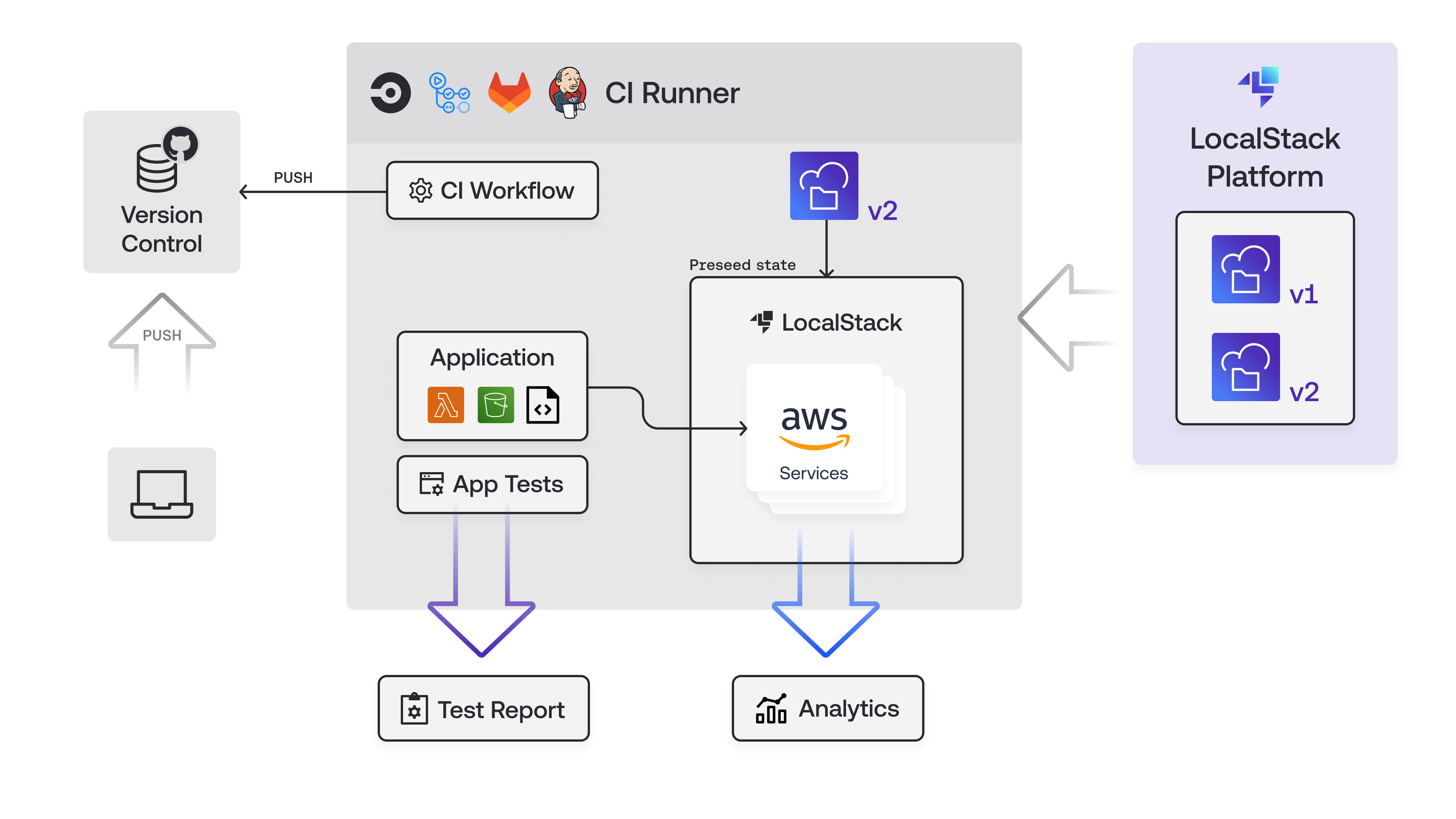
Integration with Testcontainers
Integrating LocalStack Cloud Pods with Testcontainers will improve and accelerate your testing process, particularly addressing the prevalent pain point where Infrastructure as Code (IaC) tools like Terraform or Pulumi face challenges running against LocalStack during tests. Traditionally, this limitation nudged developers towards the more cumbersome and time-intensive route of utilizing SDK clients to create resources manually. However, the synergy between Cloud Pods and Testcontainers’ features elegantly circumvents this bottleneck. By enabling developers to swiftly inject predefined state into the LocalStack container, these tools collectively foster a more efficient and seamless integration. This capability not only saves precious time but also allows developers to bypass the initial setup hurdles and leap directly into the crux of actual testing. Consequently, this integration harmonizes the flow between local and cloud environments, ensuring a smoother and more productive development lifecycle.
In our sample application, we have covered two scenarios of provisioning our infrastructure for testing: using Cloud Pods
stored on the LocalStack Platform and using the locally stored state file. You can view the full test suites in the same
repository, under the src/test folder.
Cloud Pods
Setting up the testing environment for running application tests against LocalStack is easy and straightforward:
@Container protected static LocalStackContainer localStack = new LocalStackContainer(DockerImageName.parse("localstack/localstack-pro:latest")) .withEnv("LOCALSTACK_AUTH_TOKEN", System.getenv("LOCALSTACK_AUTH_TOKEN")) .withEnv("LOCALSTACK_HOST", "localhost.localstack.cloud") .withEnv("LAMBDA_RUNTIME_ENVIRONMENT_TIMEOUT", "60") .withEnv("AUTO_LOAD_POD", "terraform-shipment-pod");- The @Container annotation is used in conjunction with the Testcontainers annotation (at the top of the class) to mark containers that should be managed by the Testcontainers framework.
- A new instance of a
LocalStackContainerusing the LocalStack Docker image taggedlocalstack-pro:latestis created. LOCALSTACK_AUTH_TOKENenvironment variable refers to your own token for the Pro license.LOCALSTACK_HOSTis the name of the host that exposes the services externally. This host is used, for example, when returning queue URLs from the SQS service to the client.LAMBDA_RUNTIME_ENVIRONMENT_TIMEOUTsets the timeout for the Lambda runtime environment to 60 seconds.- Most importantly, to get the ball rolling,
AUTO_LOAD_PODwill tell LocalStack which Cloud Pod to fetch and inject from the remote platform.
Before testing can start, we still need to remember that setting up the necessary resources takes time, even if it’s just a few seconds. That’s why we need to make sure that they exist before we use them. In this instance, we picked the Lambda function as a checkpoint, but depending on your own resources and workflows tested, this can be adapted:
@BeforeAll static void waitForLambdaToBeReady() {
LambdaClient lambdaClient = LambdaClient.builder() .region(Region.of(localStack.getRegion())) .endpointOverride(localStack.getEndpointOverride(LocalStackContainer.Service.LAMBDA)) .credentialsProvider(StaticCredentialsProvider.create( AwsBasicCredentials.create(localStack.getAccessKey(), localStack.getSecretKey()))) .build();
WaiterOverrideConfiguration overrideConfig = WaiterOverrideConfiguration.builder() .maxAttempts(20) .build();
LambdaWaiter waiter = LambdaWaiter.builder() .client(lambdaClient) .overrideConfiguration(overrideConfig) .build();
GetFunctionRequest getFunctionRequest = GetFunctionRequest.builder() .functionName("shipment-picture-lambda-validator").build();
WaiterResponse<GetFunctionResponse> waiterResponse = waiter.waitUntilFunctionExists(getFunctionRequest); waiterResponse.matched().response().ifPresent(response -> LOGGER.info(response.toString()));
}To summarize, this code snippet configures a Lambda client and uses a waiter to check and wait until the specified Lambda
function (shipment-picture-lambda-validator) is ready before proceeding with the tests. This ensures that the tests only
run when the necessary AWS resources are available in the LocalStack environment.
After everything is in place, the Spring Boot application will start up, and the tests can make sure the business logic is behaving as expected.

Local state
Similarly to using Cloud Pods, we can harness a similarly efficient strategy with locally exported state files. These files are
integrated into the Docker container as mounted volumes, residing at a designated path (etc/localstack/init-pods.d). Just like
with initialization hooks, this setup ensures that the container scans this specific folder during startup, identifying and
utilizing relevant files, thereby optimizing infrastructure initialization with ease. The setup will look the same, with the
exception of one field, where we provide the path to our file:
@Container protected static LocalStackContainer localStack = new LocalStackContainer(DockerImageName.parse("localstack/localstack-pro:latest")) .withEnv("LOCALSTACK_AUTH_TOKEN", System.getenv("LOCALSTACK_AUTH_TOKEN")) .withEnv("LOCALSTACK_HOST", "localhost.localstack.cloud") .withEnv("LAMBDA_RUNTIME_ENVIRONMENT_TIMEOUT", "60") .withFileSystemBind("src/test/resources/init-pods.d", "/etc/localstack/init-pods.d");The exported state resides in the src/test/resources/init-pods.d folder, which binds to the /etc/localstack/init-pods.d
path in the container.
Integrating LocalStack’s Cloud Pods with Testcontainers allows for efficient infrastructure setup and data preparation across various scenarios. It provides a practical approach to layering different datasets on the same infrastructure, which is crucial for testing as many scenarios as needed.
Additional Details
Cloud Pods are typically stored remotely, with the default storage location being the LocalStack platform. Nonetheless, for organizations with specific data regulations or sovereignty concerns that preclude the use of remote storage infrastructures, LocalStack offers the flexibility to store Cloud Pods on-premises, ensuring full control over storage. In terms of alternative storage options, LocalStack supports two main types: S3 bucket remote storage and ORAS (OCI Registry as Storage) remote storage. Additionally, LocalStack facilitates the management of these storage options through a command-line interface (CLI), providing functionalities to create, delete, and list these remote storage locations for Cloud Pods. You can find all the necessary tools for that in the documentation.
Limitations
Cloud Pods are a powerful feature, though they are optimized to work with certain configurations. Primarily, matching the major version of LocalStack with that of the Cloud Pod ensures compatibility and smooth functionality. Additionally, while most services are fully supported, there are instances where certain service information may not be completely serialized into a Cloud Pod. These nuances are minor and generally manageable within the framework and are also constantly documented and updated.
Conclusions
Cloud Pods are fundamentally transforming the landscape of testing for AWS-powered applications, by offering a scalable and efficient way to replicate AWS infrastructure locally and in CI, whether it’s for fast development or integrating with popular frameworks. This breakthrough, coupled with remote storage for Cloud Pods, significantly enhances team collaboration, ensuring seamless and consistent testing experiences across the board.




